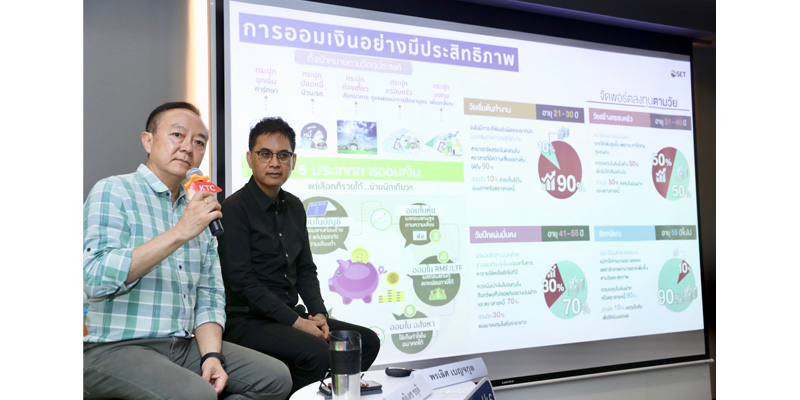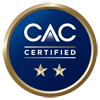
Mr. Chutidej Chayuti, Chief Finance Officer “KTC” or Krungthai Card Public Company Limited, a leader of the consumer finance business, jointly with Mr. Pornlert Benjakul, Managing Director of Winperformance Company Limited, purveyor of debt collection and recovery services, organize the #KTC FIT Talks 5: Risks Attached to Loan Sharks knowledge sharing seminar at the Conference Room, 14th floor, UBC II Building. The event was also streamed on Facebook Live on the #KTC CSR Club page. The talk revealed contrasting perspectives regarding standard loans and non-standard/shark loans. These “shark loans” remains as one of the causes of the spike in Thailand’s household debts in the past years.
Mr. Chutidej states, “‘Shark loans are caused when individuals lack the opportunity to gain access to money sources and due to financial obligations have to rely on loans offered outside of local authority. These loan sharks offer loans at extremely high daily or monthly interest rates. Moreover, if debtors fail to pay back loans, they may use violent debt collection methods. This is different from “standard loans” which is a process whereby a business or a legal entity offers loans in a transparent, fair and verifiable manner within a clear guidance of a central organization with privileges to lighten the debt load to loan applicants”
“The government is aware of the violence and risks associated with loan sharks. For this reason the government has been looking for methods to transfer non-standard loans into correct standard ones. The government launched supervised personal loan business or “Nano Finance” for low income individuals or small business owners who do not own clear income statements nor own assets as collateral or never had debt payment records, to gain access to money sources with low interest rates to aid their business practices. Nano Finance has a loan issuance amount per person of a maximum of Bt. 100,000 and a total of interest rates and other fees not exceeding 36 percent per year (Effective rate). There were 33 businesses offering Nano Finance loans by the end of March 2019 with a total of 1.91 million Nano Finance loans receiver accounts and a total of Bt. 30.669 billion in outstanding loan balance.
“Furthermore, the government has also launched provincial retail loans under supervision or “Pico Finance” a multi-purpose personal loans for loaners to make loans for personal expenses such as tuition, medical care, loan shark payments or investment in small businesses. Loan applicants may or may not own assets as collateral but are required to have a census registration, a current address or is employed at a city where the debt provider’s headquarters is located at. According to the Ministry of Finance’s most recent report released on April 9, 2019, there has been a change in requirements to provide Pico Finance loans. Pico Finance has a loan issuance amount per person of a maximum of Bt. 100,000 and a total of interest rates and other fees not exceeding 36 percent per year (Effective rate) or the first Bt. 50,000 loan amount. Loans exceeding the Bt. 50,000 mark will be subject to a total of interest rates and other fees not exceeding 28 percent per year
(Effective rate). Besides this, Pico Finance business purveyors may accept car and motorbike registration as collateral. There were 443 businesses offering Pico Finance loans in 64 provinces by the end of March 2019 with a total of 76,787 Pico Finance loans receiver accounts and a total of Bt. 599.56 million in outstanding loan balance.
“Aid in terms of “personal loans” is another option that will help solve the problem of non-standard loans to increase Thais’ quality of life. However, personal loans and credit card loans ratio remain low compared to the amount of debt generated by loans for housing and car purchases which continue to increase quickly.”
“KTC has prepared to venture into three new businesses: Nano Finance, Pico Finance and the personal loans business with car license plates as collateral. The company have made preparations and expected to be available within Q3 of this year. This new business with a new target audience that is different from before will increase the expansion of personal loans in the future, from both customer bases and financial amounts that are different from original personal loans. The company will continue to grow continuously and hopes that these businesses will become the new S-curve that generate new income for the firm on top of existing credit card and personal loans businesses. Nevertheless, the company will remain focused on maintaining high quality ports of receivables, and a low debt that do not generate profit (NPL) rate, for the benefits of consumer loan applicants and to not increase household debts to the government and society overall.”
Mr. Pornlert states in terms of debt collection, “Nowadays, debt collection is different than before with quite intense competition. Each institution have been making changes and improvements to appropriately fit with work development whether it be debt collection methods or technology. If the company had a chance to develop another company’s work operation for the Nano-Pico Finance consumer base which is different from that of the credit card and personal loans business, the company would aim for the same guidelines with emphasis on data and analysis on debtor data. In the past we have been cautious and mindful of different factors that affect debtors’ ability to pay back loans as well as laws related to debt collection, for example, the 2015 Debt Collection Act. These are external factors whereas internal operations will focus on collecting debt in a timely manner and providing first access to debtors as Nano-Pico Finance debtors surely do not have debts at only one source. We have also developed our technology to support our operations. The most important element is debtor information as data is now the determiner of who has the advantage. This depends on each company’s policies whether it will give this priority. This is certainly true for us to clearly determine debtors’ behavior and to pinpoint the target debtor group for us to analyze information and use the results to decide on business operations and develop technology to conform to debt collection. For example, current debtors are office workers who majority rely on monthly salaries to pay back their loans. These individuals do not have other occupations. The question which arises is how do we follow up on their debts. If something were to happen to this group of individuals, good debt will turn into bad ones with remaining debt which is approximately 35 percent. There will also be a group of people who will become careless and do not have discipline in paying back loans which is at a level of 34 percent. The question that arises again is what we should do. These two groups do not have much risks tied to them, although the real risks stem from unnecessary and extravagant spendings, materialism and borrowing more money to pay off debt, and lastly from poverty and unemployment, leading to insufficient funds to repay debt. When we know these debtors’ basic information, we improve on our debt collection process. Currently we are using a Virtual Collector for efficiency and timeliness which enables us to better target debtors compared to regular methods. Debtors nowadays do not pick up their phones or is unable to do so in their workplace.”
“Another important point is the different laws enforced by the government as operational guidelines. This includes the 2015 Debt Collection Act and all institutions comply with this. However, we must always check on new related restrictions or announcements. For instance, recently a meeting was held about how debt collectors may only contact debtors or their specified contact person only once per day, and there may be debt collector registration so that debtors know who called.”
“I would like to say to those who asked for personal loans and have begun to have debt. Debt must be repaid as debt collection do not lead to happiness. In the case where this is not possible, do not stress about being in debt, and set a goal about what to do. In general, debtors must stop making unnecessary payments, stop his/her greed, do not create additional debt, use existing items and only spend on basic needs. If restraint is not possible, allowance should be decreased or existing personal loans cancellation must be done to only have necessary personal loans remaining. Debts should be paid on time to maintain a good credit background, and find additional sources of income. Do not worry about debt, focus on the money that will increase to be happy. Debt is a solvable problem but only with planning, for example, finding money to pay off high interest debt, refinancing, or speaking with financial institutions to reach a compromise and each will have different guidelines. These advices will lead to a debt-free state and the return of client happiness.”



 Promotions
Promotions
 KTC U SHOP
KTC U SHOP




 Login
Login





















